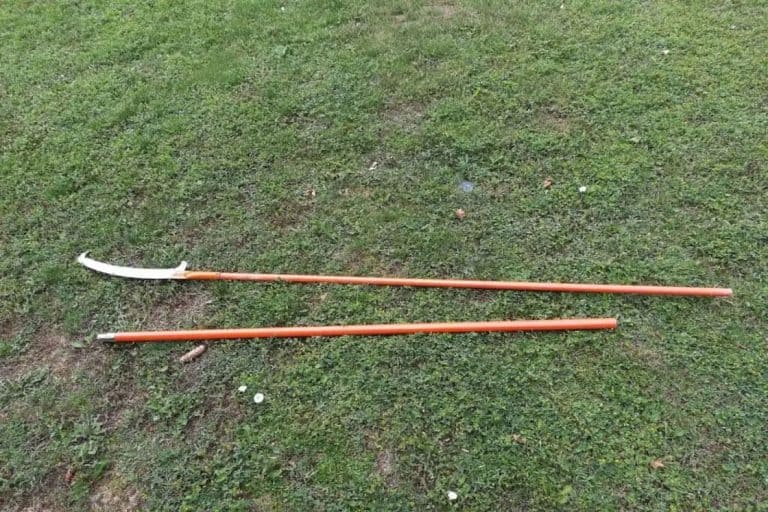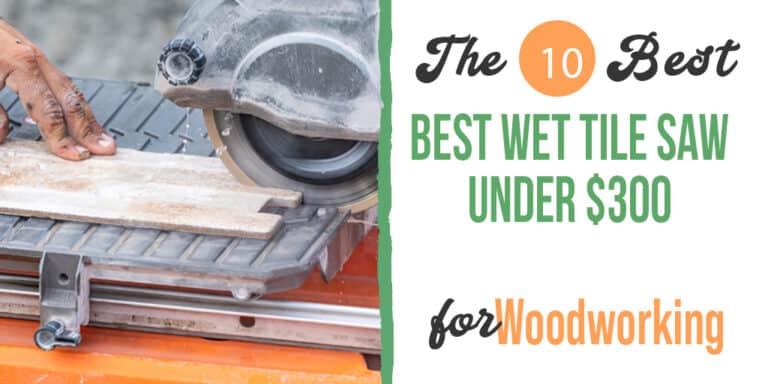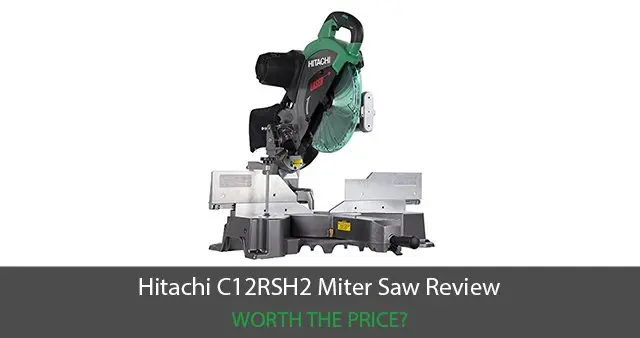While an underpowered blade can make the easiest cutting projects a hassle, you will find a dull or fragile blade to be more frustrating. Although most band saws have their own standard blades, they are usually weak and can fall apart after a short period. Like most craftsmen, you will have to look for a replacement blade.
However, finding the right blade that is compatible with your existing saw can be difficult. To make your shopping experience easier, we have compiled the best band saw blades on the market. Our review covers the high-performing replacement blades to help you meet your cutting needs.
Contents
Our Top Band Saw Blades Reviews
Timber Wolf
Timber Wolf is famous for producing premium blades that can withstand a great deal of pressure. The Timber Wolf band saw blade is one product that won’t crack under pressure. If you are looking for a durable blade that can remain productive after long hours of cutting, this model is an ideal choice for your woodshop band saw.
The blade is made of low carbide steel, a metal uniquely blended to allow for rigidity and flexibility when subjected under high pressure. One thing you may like about this blade is that its teeth coated with a silicone finish that ensures each individual tooth remains sharper for an extended period.
When it comes to the teeth, the Wolf band saw blade only has 2 to 3 teeth per inch. While this may look like a major drawback to some people, this wide spacing is the main reason for the blade’s multi-functionality. Apart from re-sawing, the blade can also crosscut without putting it at risk of breaking or any other damage.
The ¾ inches width is another great feature worth mentioning as it will allow you to create tighter curves. You will also like the reduced tension as it results in a long-lasting blade due to less wear and tear. It also results in more power which is beneficial to your saw as it won’t work very hard.
One of our best features is exceptional quality, and this is where the company outdid itself. This product is a premium blade. The teeth on the Timber saw blade are milled and not crush ground or stamped. This means they are machined from a block of steel.
In addition, they are 50 percent sharper compared to competitors’ blades. Also, since the blade is silicon steel and low carbide steel combo, the tooth edges are 20% harder than any other high carbon steel blade. This helps the blades to remain sharper for longer.
There is also the precision induction hardening that increases the blade’s shelf-life and the ductile steel that extends flex life. The blade is a combination of hook and skip tooth while the gullet boasts of exceptional roundness and depth that increases the speed and removal of dust.
What We Like
- Low carbide steel and silicon construction for enhanced sharpness
- Designed for re-sawing and also ideal for crosscutting
- Effective in low horsepower saw
- Milled teeth and durable design
- 2-3 teeth per inch
What We Don’t Like
- Unclear tensioning instructions
- Sometimes blade wobbles
- Blade dulls very fast
Skil 80151
If you are looking for a good deal that does not compromise performance, then the Skil 80151 band saw blade assortment is a must get as it fits the bill. At 60 inches, this blade works with most 9 inches band saws. In addition, you may also like the optimized tooth geometry that reduces friction while enhancing cutting.
When it comes to versatility, each Skil saw blade pack comes with three blades to fit a wide range of cutting jobs. It is important to mention that the three blades are not for replacement in case you damage one. They are slightly different to boost resourcefulness. For instance, you can use the 1/8 inches 15 TPI blade for tight curves and smooth cuts.
There is also the ¼ inches blade with a 6 TPI which is aggressive. However, unlike the 3/8 inches blade, it can make tighter curves. Then there is the 3/8 inches blade which also has a 6 TPI that is quite fast and aggressive. One remarkable feature we liked about these blades is that both the small and large teeth per inch arrangements have fewer weld points compared to other band saw blades.
This means that this product has a few weak sensitive points which are known to be an issue even for the most band saw blades. In addition, the 80151 saw blade boasts of premium grade steel construction which helps the blade to resist heat buildup. This makes the blade long-lasting and can even be used in jobs that require high speed.
Also, the versatility of the blades makes this model perfect for use in different applications. The blades can handle both metal and wood applications comfortably. Its alternating teeth also increases the blade’s versatility while the sharpness is great as it lasts longer.
However, this saw blade does not deliver impressive performance on hardwood while the gauge metal is heavy. The blade is also thin and may buckle, which can make it bend out of shape due to the strain. Overall, this is a great band saw blade that will help you to simplify your diverse projects, especially if you intend to handle materials with different densities.
What We Like
- Alternating teeth increases the tool’s versatility
- Optimized tooth geometry for reducing friction
- Produces less heat for continuous safe use
- Few weak sensitive points
- Good value in three-pack
What We Don’t Like
- Does not perform well on hardwood
- The blade can bend out of shape
- Might be too thin for some cuts
Bosch BS6412
The Bosch BS6412 band saw blade is an excellent option for cutting metal and ideal for people that are comfortable with metal crafting. The enhanced features the model comes with will allow you to slice through some thick pieces of wood within a short period. The main body of the blade clocks in at 0.25 inches. Although this may feel too wide, it’s important to note that the thicker size is more durable compared to its rivals.
One incredible feature of this saw blade is the wavy tooth pattern that enables it to deliver cleaner cuts without stopping. That quality of cleaner cuts will allow you to cut into three inches and four inches square tubing. The blade also comes with 24 teeth per inch. This amount of contact space is large enough to enable you to cut through and modify your metal.
The Bosch saw blade is also durable so you don’t have to look for replacements. You can also use it to cut thin metals and hard steel and is perfect for a cordless saw as it measures 32 7/8 inches in length. The quality of the saw blades is worth mentioning as the product features premium-grade steel which increases its durability and strength.
Other incredible features include flexibility and heat resistance. First, this blade is a high pitch product with 24 TPI. The high pitch will enable you to make exceptional cuts with excellent quality. Additionally, the optimized tooth geometry (wavy tooth pattern) increases the flexibility and versatility of the blade. As such, you can cut wood as well as thin and thick metal.
Another good thing about the BS6412 band saw blade is its ability to resist heat. So, you can cut at low or high speed without worrying if the blade will heat up. This also increases the number of applications you can use the blade.
If you like cutting metal pieces precisely, then this product should be your new blade on your band saw. It’s also the best blade for applications that require high cutting speeds and retains sharpness for longer, which eliminates frequent sharpening.
What We Like
- 0.25 inches thickness to balance durability and flexibility
- You can use it for extended periods without warping
- Wavy tooth pattern for precise cuts
- Perfect for creating straight cuts
- 24 teeth per inch
What We Don’t Like
- May not cut thick material precisely
- Prevalent weld cracks
Dewalt DW3984
If you are looking for blades that you can use to cut a wide range of materials, the Dewalt DW3984 is an excellent choice. It also comes with a pack of three. So, you don’t have to worry about looking for a replacement blade immediately after the purchase.
The versatile 24 TPI saw blade cuts through different materials while leaving a professional and smooth finish. The blade is durable and will give you great value. Despite being made of high-speed steel, the saw blade delivers impressive cutting performance.
It features cobalt reinforcements and 24 TPI for enhanced wear resistance and durability. This enables the Dewalt blade to slice through a variety of wood and metal. However, it delivers a smooth finish at a slower pace. The alloy steel backer makes the blade sturdy and durable enough to tackle a range of metal cutting jobs such as crosscuts, ripping and more.
In addition, the Matrix II high-speed steel (HSS) edge protects the blade from heat and also helps it to retain its sharpness for a long period. Although the DW3984 band saw blade might be a bit slower compared to lower TPI blades, its exceptional finish compensates for the slower pace.
The blade makes working on sheet metal a breeze while the lower pitch will allow you to make quick cuts without sacrificing the clean and smooth finishes you like. While this saw blade is designed for metals, it can also tackle wood. However, you will have to be patient as it cuts slowly.
This highly durable blade from Dewalt is long-lasting and also strong. Some have complained about the blade wearing easily. However, this may depend on the toughness of the material they are using it to cut.
For the maximum performance of your band saw, this product may be an excellent pick. It’s reinforced with cobalt and features Matrix II HSS edge for enhanced edge retention capacity and exceptional durability. Overall, the saw blade is perfect for people that want an excellent cut or smooth finishes.
What We Like
- The Matrix II HSS edge that protects the blade from heat
- Alloy steel backer for sturdiness and durability
- Reinforced with cobalt for maximum longevity
- High TPI for precise and clean cuts
- Heat and wear resistance
What We Don’t Like
- Delivers smooth finishes at a slower pace
- The band is weak at the seams.
- Higher TPI slows the cutting speed
Band Saw Blades Features and Considerations
Choosing the best band saw blade can be easy when you know the essential features to pay attention to. When shopping for a replacement band saw blade, here’s what to look for:
Shape of Blade
This refers to the design of the teeth and the space between the teeth. The most common shapes include:
Variable Tooth
When it comes to the variable tooth, there are two types of variable style blades:
- Variable Pitch Blade: These blades have different pitches throughout the blade length. For instance, a 6 to 10 pitch blade has 6 TPI (Teeth Per Inch) followed by a group of 10 TPI teeth.
- Variable Tooth Blade: These are band saw blades with varying gullet depth or different set angles. They reduce vibration during cutting.
![Best Band Saw Blades [2023 Review] 1 Best Band Saw Blades [2023 Review] Band saw blade cutting wood](https://brandisawyer.com/wp-content/uploads/2020/02/best-band-saw-blades-04-1024x982.jpg)
When you use a set and pitch blade that is constant, it may create harmonic vibration that can shorten the lifespan of the saw during sawing. It may also result in poor finish and increase noise pollution.
However, if you opt to use a variable tooth blade, you’ll eliminate the harmonic vibrations since the difference in the set, gullet depth and pitch will break the rhythm. These types of blades are ideal for re-sawing as they prevent vibration from spoiling the work.
Hook Tooth
These blades come with a hook and have a 10-degree positive rake angle that makes it easy for them to dig deeply into your material while you are cutting. The deep gullets on these blades enable them to take deep bites on each cut. Hook tooth blades are perfect for cutting through tough material like non-ferrous metals or hardwood. However, the blades are unsuitable for making smaller, accurate cuts.
Skip Tooth
These types of blades have flat gullet and zero rake angle. Skip tooth blades have shallow gullet that is ideal for cutting large sections. They also cut a wide range of materials including different types of wood, plastic, and metal. The wide gullets enable them to slice through softer material such as wood without clogging. However, they lack precision.
Regular Tooth
Regular tooth blades or standard saw blades have zero rake angle with conventional tooth design. They offer precise cuts for softer materials such as thin sheets and softwood. They are also perfect for general purpose cutting and contour cutting.
![Best Band Saw Blades [2023 Review] 2 Best Band Saw Blades [2023 Review] Band saw blade](https://brandisawyer.com/wp-content/uploads/2020/02/best-band-saw-blades-01-1024x683.jpg)
Blade Kerf/Thickness
The kerf or thickness of a blade depends on the width. For instance, thinner blades tend to have narrower kerf, while thicker blades have broader kerf. Thinner kerf blades are ideal for board re-sawing or veneer sawing jobs. On the other hand, you can use thicker kerf to cut greenwood.
Additionally, longer blades are usually thicker to boost their stability while shorter band saw blades are often thinner. The kerf may not be an essential feature if you are not making veneers using a thinner blade that enables you to get more layers from pieces of wood.
Coarse vs Fine Blades
Typically, this refers to the number of teeth on the blade. A blade is rough or coarse if the number of teeth is on the lower side. These types of blades usually come with 2 to 6 TPI. They are ideal for cutting quickly through soft material and creating large cuts.
However, you can use these to make the accurate cuts that most woodworkers would want to make. On the other hand, a fine blade comes with a high number of teeth, usually 14 to 24 TPI. These blades are perfect for making precise cuts. The high number of teeth enables them to create small, precise cuts.
Fine blades are ideal for cutting harder materials such as metal and thin sheets. However, just like the coarse blades, they also have some drawbacks. You can’t use these to make larger cuts and tend to dull a lot easier due to the high number of teeth, which makes them unsuitable for quick cutting.
![Best Band Saw Blades [2023 Review] 3 Best Band Saw Blades [2023 Review] Man making sure that his band saw blades are working properly](https://brandisawyer.com/wp-content/uploads/2020/02/best-band-saw-blades-03-1024x726.jpg)
Blade Width
Typically, the width of the blade is based on the application of the blade. That said, it is important to mention that the band saw blades come in different widths. For example, more flexible and narrower blades are an excellent choice for intricate and tight curves. They are also ideal for smaller circles.
For veneers, straight cuts and cutting large boards into thinner pieces of wood, wider blades are the perfect option as they are more stable and stiffer. They also have lower pitches compared to their narrower counterparts that are usually higher pitched.
Teeth Per Inch (TPI)
Band saw blades have different TPIs. TPI is the unit used for measuring the pitch of the blade. If the pitch is higher, you will have precise and smooth cuts. However, they are slower compared to lower-pitched blades. On the other hand, lower-pitched blades are aggressive. However, they create a rough finish. So, if your projects require accuracy and less re-working, it would be ideal to go for a higher-pitched band saw blade.
Set of Tooth
Generally, blade teeth are slightly bent towards the right and left to offer clearance to the back of the band saw blade. Due to this, the final cut width will be wider compared to the thickness of the blade. That said, there are many types of tooth set that are ideal for different applications which include:
![Best Band Saw Blades [2023 Review] 4 Best Band Saw Blades [2023 Review] Band saw blade cutting wood](https://brandisawyer.com/wp-content/uploads/2020/02/best-band-saw-blades-02-1024x682.jpg)
- Raker Set of Tooth: These are blades that come with a raker set and have three-tooth sequences with one bent towards left and the next to the right while the third tooth is unset or straight.
- Alternate Set of Tooth: An alternate set has one tooth bent towards left and the next towards the right.
Material
Several band saw blades use different types of materials such as bimetal, hardened carbon steel (HCS), high-speed steel (HSS) and carbide tungsten. The least expensive and common types are the high-speed steel and hardened carbon steel. However, they have a short lifespan.
Bimetals are a bit expensive and are a combination of HCS and HSS, which provides a balanced mix of value and longevity. Carbide tungsten blades are more expensive and combine longevity with durability.
Wrap Up
Although there are many options available with special features that make them ideal for cutting metal or slicing through wood, the right band saw blade is the one suited to your needs. That said, you should choose a blade designed to cut your material rather than picking the first blade you see on the shelf. All the blades on our list have been selected carefully to ensure you get the one that is ideal for you.
![Best Chainsaw Bar in 2023 – [Get the Smoothest Cuts] 6 Best Chainsaw Bar in 2023 – [Get the Smoothest Cuts] Best-Chainsaw-Bar](https://brandisawyer.com/wp-content/uploads/2021/03/Best-Chainsaw-Bar.jpg)


